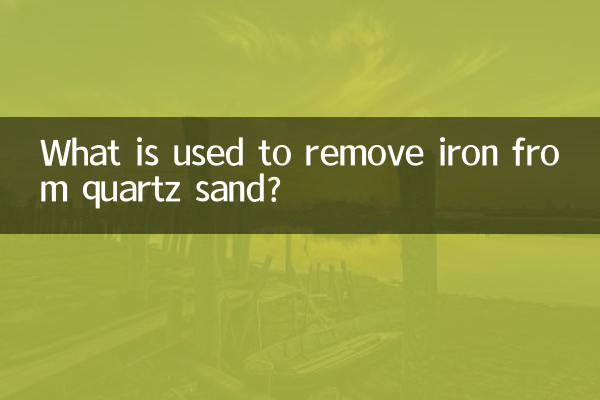What to use to remove iron from quartz sand: full analysis of methods and techniques
As an important industrial raw material, quartz sand is widely used in glass, ceramics, electronics, chemical industry and other fields. However, iron impurities in quartz sand will seriously affect its quality and application results. Therefore, iron removal is one of the key steps in quartz sand purification. This article will introduce in detail the methods and technologies of quartz sand iron removal, and attach relevant data to help you better understand and choose a suitable iron removal solution.
1. Sources and hazards of iron impurities in quartz sand

Iron impurities in quartz sand mainly come from iron-containing minerals in raw ores (such as hematite, magnetite, etc.) and mechanical iron introduced during mining, transportation and processing. The presence of iron impurities will reduce the whiteness and transparency of quartz sand, affecting its application value in high-end fields.
2. Common methods for removing iron from quartz sand
According to the nature and content of iron impurities, quartz sand iron removal methods can be divided into three categories: physical methods, chemical methods and biological methods. Here are common iron removal methods and their pros and cons:
| method | principle | advantage | shortcoming |
|---|---|---|---|
| Magnetic separation | Using magnetic differences to separate iron impurities | Simple operation and low cost | Poor effect on non-magnetic iron impurities |
| Acid leaching | Dissolve iron impurities with acid | Thorough iron removal and high efficiency | Large environmental pollution and high cost |
| flotation | Separating Iron Impurities Using Differences in Surface Properties | Suitable for fine iron impurities | High drug consumption and complicated process |
| Microbiology | Dissolving iron using microbial metabolites | Environmentally friendly and low energy consumption | Long cycle and unstable effect |
3. Technical Selection of Quartz Sand for Iron Removal
Choosing an appropriate iron removal technology requires comprehensive consideration of the type, content, particle size distribution of iron impurities in quartz sand, and the quality requirements of the final product. The following are the applicable scenarios for several common quartz sand iron removal technologies:
| technology | Applicable iron impurity types | Applicable quartz sand particle size | Iron content after treatment (ppm) |
|---|---|---|---|
| High gradient magnetic separation | magnetic iron minerals | 0.1-1mm | ≤50 |
| Hydrochloric acid leaching | nonmagnetic iron minerals | <0.5mm | ≤20 |
| Compound acid leaching | Various iron impurities | <0.3mm | ≤10 |
| bioleaching | inclusion iron | <0.1mm | ≤30 |
4. Practical application cases of quartz sand iron removal
The following is a comparison of the actual effects of different iron removal technologies used in a quartz sand processing plant:
| Craftsmanship | Iron content in raw sand (ppm) | Iron content after treatment (ppm) | Iron removal rate (%) | Cost (yuan/ton) |
|---|---|---|---|---|
| Single magnetic separation | 1200 | 300 | 75 | 50 |
| Magnetic separation + acid leaching | 1200 | 50 | 95.8 | 150 |
| Compound acid leaching | 1200 | 15 | 98.7 | 200 |
5. Future development trends of quartz sand iron removal
With the improvement of environmental protection requirements and technological progress, quartz sand iron removal technology is developing in the direction of high efficiency, low consumption and environmental protection. In the future, microbial iron removal technology and green chemical iron removal technology will become research hot spots. At the same time, the application of intelligent control systems will further improve iron removal efficiency and stability.
6. Conclusion
Iron removal from quartz sand is a key step to improve its quality. Choosing the appropriate method requires comprehensive consideration of iron impurity characteristics, product requirements and cost factors. At present, magnetic separation and acid leaching are the most widely used technologies in industry, while green technologies such as microbial methods have broad development prospects. Enterprises should rationally select or combine multiple iron removal technologies according to their own needs to achieve the best economic and environmental benefits.

check the details

check the details